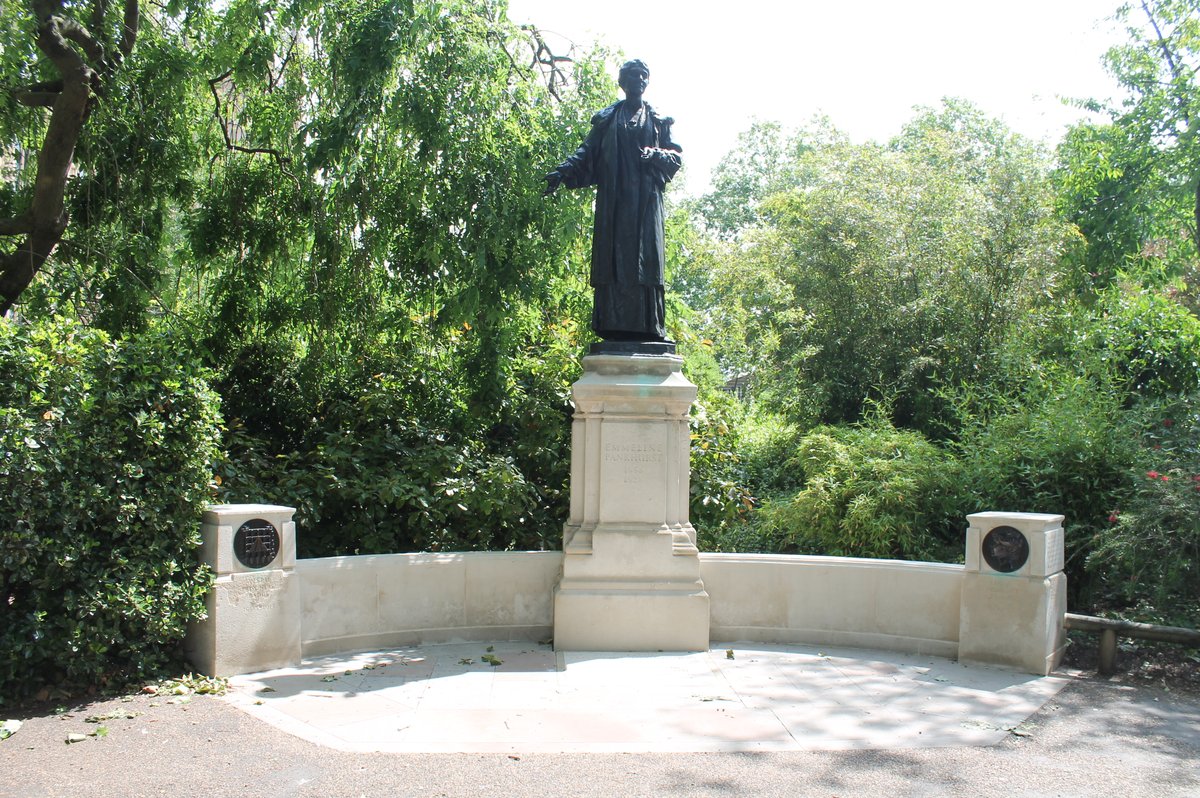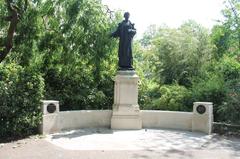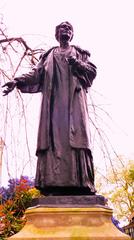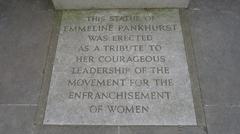
Emmeline and Christabel Pankhurst Memorial: Comprehensive Visitor Guide
Date: 14/06/2025
Introduction
The Emmeline and Christabel Pankhurst Memorial, located in Victoria Tower Gardens beside the Palace of Westminster, stands as a powerful testament to two trailblazers of the British women’s suffrage movement. Emmeline Pankhurst and her daughter Christabel transformed the landscape of British democracy through their leadership of the Women’s Social and Political Union (WSPU), championing women’s enfranchisement with the motto “Deeds not Words.” This guide offers an in-depth look at the memorial’s history, artistic features, visiting information, accessibility, and tips for making the most of your visit to this key site in London’s historical and cultural heritage (English Heritage; Historic England; UK Parliament).
Table of Contents
- Historical Context: The Pankhursts & Women’s Suffrage
- Memorial Origins and Symbolism
- Artistic Design and Features
- Visiting the Memorial: Hours, Tickets & Accessibility
- Nearby Attractions
- Visitor Tips
- Frequently Asked Questions (FAQ)
- Resources and Further Reading
- Conclusion and Call to Action
Historical Context: The Pankhursts & Women’s Suffrage
Early Activism and the WSPU
Emmeline Pankhurst (1858–1928) was raised in a politically engaged Manchester family and attended her first suffrage meeting at age 14 (English Heritage). With her husband, Richard Pankhurst, she hosted reformers and suffragists at home, fostering an environment of activism. Christabel Pankhurst (1880–1958), Emmeline’s eldest daughter, followed in her footsteps, later becoming a formidable strategist and speaker for the movement (Historic England).
In 1903, Emmeline and Christabel founded the WSPU, distinguishing themselves from other organizations by adopting direct action and civil disobedience. Their tactics included demonstrations, processions, window-smashing, and hunger strikes. The WSPU’s activism led to widespread arrests—including Emmeline’s repeated imprisonments—but also drew public attention and sympathy (History Hit; The Independent).
World War I and Legislative Victory
During World War I, the suffragettes suspended militant actions and supported the war effort, with Emmeline establishing nurseries and caring for children affected by the conflict (London Remembers). The Representation of the People Act 1918 enfranchised millions of women over 30; full voting equality was achieved in 1928, shortly before Emmeline’s death (History Tools). Christabel was later honored with a damehood and continued her advocacy in the United States (Historic England).
Memorial Origins and Symbolism
Following Emmeline’s death, supporters established the Pankhurst Memorial Fund to honor her legacy by erecting a public statue, among other tributes. Prime Minister Stanley Baldwin unveiled the bronze statue in 1930, sculpted by Arthur George Walker and set on a plinth designed by Sir Herbert Baker (Everything Explained Today). The statue’s location near Parliament required a special bill, symbolizing the suffragette movement’s challenge to political authority.
In 1958, the statue was repositioned and expanded to include bronze medallions commemorating Christabel Pankhurst and the WSPU, designed by Peter Hills. The memorial’s classical exedra-like screens create a contemplative space, while medallions honor those imprisoned for the cause, symbolized by the WSPU Prisoners’ Badge (Art UK; Exploring London).
The memorial soon became a rallying point for commemorations and annual gatherings. Its listing as a Grade II* structure and appearance on a 1968 postage stamp highlight its enduring national significance (Wikipedia).
Artistic Design and Features
- Statue: Arthur George Walker’s bronze statue depicts Emmeline Pankhurst in oratorical pose, right arm outstretched and left hand holding an eyeglass (Historic England).
- Plinth and Inscriptions: The Portland stone plinth bears her name, life dates, and a dedication to her leadership. A metal box inside reportedly holds personal letters and press clippings (Exploring London).
- 1959 Additions: Flanking screens end with medallions—a portrait of Christabel Pankhurst on the right, and the WSPU Prisoners’ Badge on the left, each with explanatory inscriptions (Art UK).
- Setting: The memorial is set within tranquil gardens, with sightlines to the Palace of Westminster, reinforcing its symbolic connection to democratic change.
Visiting the Memorial: Hours, Tickets & Accessibility
Location
- Victoria Tower Gardens, Millbank, London SW1P 3JA (Google Maps)
- South of the Palace of Westminster along the Thames embankment
Opening Hours
- Open Daily: Dawn to dusk (typically 7:30 am until sunset)
- Admission: Free, no ticket required
Accessibility
- Wheelchair Accessible: Level, paved paths throughout the gardens
- Public Transport: Westminster Underground Station (Jubilee, District, and Circle lines) is a 5-minute walk; bus routes 3, 87, 88, and 453 serve the area (Transport for London)
- Cycling: Santander Cycles docking stations nearby
- Facilities: Public restrooms at Westminster Station; benches available; children’s playground at the garden’s north end
Nearby Attractions
- Houses of Parliament & Big Ben: Iconic landmarks adjacent to the gardens
- Westminster Abbey: A short walk away, steeped in history
- Churchill War Rooms: Explore Britain’s WWII command center
- Thames Riverwalk: Enjoy views along the river, with cafés and restaurants nearby
- Parliament Square: Statues of other political reformers and suffrage campaigners
Visitor Tips
- Best Time to Visit: Early mornings and late afternoons offer quieter experiences and excellent lighting for photography
- Photography: Capture the statue with the Palace of Westminster as a dramatic backdrop; morning light is ideal
- Events: Look for commemorations on International Women’s Day and suffrage anniversaries
- Etiquette: Respect the memorial; laying flowers or ribbons is encouraged, but climbing is not permitted
Frequently Asked Questions (FAQ)
Q: Is there an entry fee or ticket required?
A: No, the memorial is free to visit within Victoria Tower Gardens during opening hours.
Q: Are guided tours available?
A: There are no dedicated tours, but several Westminster walking tours include the site (Women of London Tours).
Q: Is the memorial wheelchair accessible?
A: Yes, the gardens and memorial are accessible via paved, level paths.
Q: What are the garden’s opening hours?
A: Generally from 7:30 am until dusk; times may vary seasonally.
Q: Are there facilities or cafés nearby?
A: No cafés in the gardens, but many options are close by along Millbank and at Westminster Station.
Q: Can I see virtual tours or images online?
A: Yes, visit Historic England or Art UK for visuals and resources.
Resources and Further Reading
- English Heritage: Emmeline & Christabel Pankhurst Memorial
- Historic England: Listing Details
- UK Parliament: Women’s Suffrage
- Everything Explained Today: Memorial History
- The National Archives Blog: Emmeline Pankhurst Memorial
- Art UK: Artistic Details
- Exploring London: Memorials
- Museum of London: Suffragettes Collection
- The National Archives: Women’s Suffrage
- BBC History: Emmeline Pankhurst
Conclusion and Call to Action
The Emmeline and Christabel Pankhurst Memorial is a cornerstone of London’s historical landscape, offering a compelling glimpse into the relentless struggle for women’s suffrage and equality. Its commanding presence, powerful symbolism, and proximity to the seat of British democracy make it an essential stop for anyone interested in history, politics, or social justice. Whether you’re attending a commemorative event, joining a walking tour, or exploring at your own pace, this memorial invites reflection, appreciation, and inspiration.
To deepen your experience, download the Audiala app for guided audio tours and updates, explore our related articles on women’s history, and follow us on social media for the latest news and events about London’s heritage sites.
Sources
- English Heritage: Emmeline & Christabel Pankhurst Memorial
- Historic England: Listing Details
- UK Parliament: Women’s Suffrage
- Everything Explained Today: Memorial History
- The National Archives Blog: Emmeline Pankhurst Memorial
- Art UK: Artistic Details
- Exploring London: Memorials
- Museum of London: Suffragettes Collection
- The National Archives: Women’s Suffrage
- BBC History: Emmeline Pankhurst






















































































































































































































































